If you only have this device, then you need to know the answer to this, or you can stick your head back into the sand. If I am a potential client to a calibrator that only pulls out a tri-stim device to calibrate my TV, I’d want to know the answer to this.
Here is some additional data on how calibration tables come about. For some reason, a lot of enthusiasts have come to believe that these offset tables are a result of examining the performance of perhaps hundred of displays. Lots of data points to build to a conclusion that one brand of TV behaves a certain way. This is the idea of clustered data. 95% of the samples behave in a similar way with the occasional outlier data points. Create the tables based on the performance of the 95%. Reasonable approach to things.
Well, the hundreds of displays number is actually closer to one or two or three displays at most. Those are big conclusions to draw that an entire line of display technology will all behave in a manner exactly like three samples.
Displays within the same model run don’t even behave in a consistent manner when the manufacturer changes its supplier of LED light bulbs in the middle of the production run. It’s not like they owe it to anyone to make an announcement that such a thing is happening. People buying a TV for the first 4 months of a production run could have very different results versus those in the last 4 months of the same run.
I don’t need to draw conclusions for you. The information is laid out here on how tables work and how they might not work. The best cheap solution is still to profile the tri-stim meter against a reference spectrometer even as inexpensive as a colormunki. People are always free to continue believing whatever they want, but I won’t take the word of salesmen that something is just as good as a spectro.
Addendum … With four samples displayed here, I wonder if anyone has noticed a certain trend? The errors get larger as the patterns get brighter. A proper 6500K reading from the Jeti always seems to end up about 300K to 500K on the blue side. So if people are relying on the C6 here, it would always end up with calibrated numbers on the redder side of things, say 6100K range. Couldn’t another correction factor be used here that subtracts out 300K to 500K for patterns at 40% intensity or more? Again while not perfect, it would improve all the dE numbers by 2 to 3 or more across the board. Just food for thought. Take your readings and add 400K to the blue side and you have your own tables.
Further to this one person asked about not knowing if the i1 pro was accurate to begin with. Well here is a picture of the results on the same panasonic LCD set from above take with my I1 Beamer (before it was called the i1 pro) … circa 2002 when I first got that unit. It has never been sent back for recalibration. (A testament to the industry people that said that the i1 pro units don’t drift much at all if you take care of them). This is what I expected from a more budget spectro and as expected, the probe has more difficulty reading the 10% and 20% patterns. It is not $11000 like the Jeti, but it is pretty close … as we expect. This is what a reading of a tri-stim probe with tables should look more like.
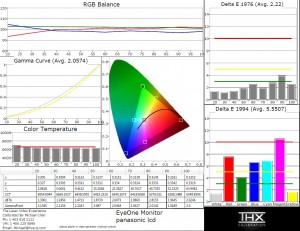
This second set is looking at the LG LED/LCD 55LX9500 set I have in my living room. A reader asked if I could take a reading with my i1 on this LED type tv and compare it to the JETI. Easier said than done, given the lighting in the room, but I sort of figured out a way. I draped this large black fleece blanket over the Display and the tripod mounted i1 Beamer. I took a series of readings and because there was some light leakage , I figured I would take another set of readings with the Jeti under the same room conditions. So these jeti readings will not look like the other ones taken at night in a dark room. But they are consistent with the i1 for an apple to apple comparison.
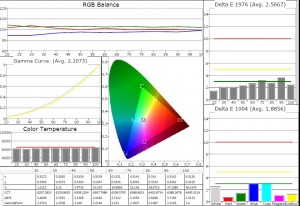
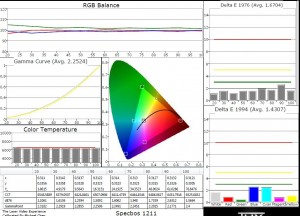
Not the same, but the results seem to reflect a dE difference of about 1.0 between the Jeti and the i1 Beamer under the same light conditions. Not that different than what was seen on the Panasonic LCD set. One anomolie occurred during the first run with the i1 in Calman so I ran it again with my THX Chromapure program just to double check. The Jeti ran the same on both programs and the i1 beamer ran normal. I put the i1 back to Calman and it ran normal this time … matching the behavior seen with the Chromapure program.
Once more, I know going in that the i1 beamer is not going to mirror what the $11000 Jeti reads, but I expect and hope that it will be close and it is in both cases for both displays.

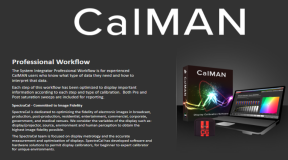
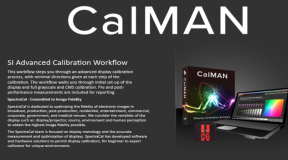

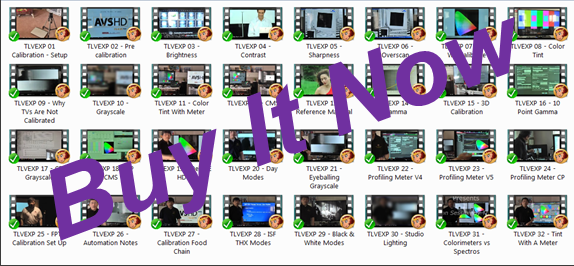
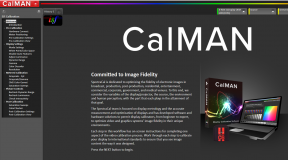
25 Comments
Alex
(January 16, 2012 - 7:44 am)Can I get a datestamp on this article?
It’s a very very good article, by the way. Albeit depressing for the owners of colorimeters. I suppose the best would be to own BOTH the iPro and a colorimeter so you could get the speed and accuracy of both on a given display.
Randal
(January 25, 2012 - 8:49 am)Excellent article. For some enthusiasts economic situations could exist where the purchasing of a $1000 spectrometer is out of the question or to even borrow or rent one again is out of the question. Even if one does have such a equipment; how accurate is the reference unit?
tlvexp
(January 25, 2012 - 9:22 am)A man with two watches never knows what time it is.
I’m not telling everyone to rush out and buy a spectro. The i1 pro can usually be found for under $1000 and the Color Munki Spectro is usually well under $500. The article simply presents the argument that one should not put blind trust in calibration tables. They are not always right … or in the case demonstrated in the article … one was close and three were much further off. The sets were not cherry picked … they were simply the 4 sets I decided to put the meter to.
There is a way to make the tables better. They just are not there yet, but hopefully adjustments will be made and the accuracy will improve.
The thing about the spectros as mentioned in the article is that their behavior does not change depending on the type of TV technology you ask it to read. They are consistent on LCD … Plasma … LCD/LED … DLP … OLED … LCOS … it is not a Wheel of Fortune where you cross your fingers not knowing what the meter results will look like.
I’ve added a shot of the same panasonic LCD set, but using my aging i1 Beamer / pro. This is the verification I expect when I put a second meter up to a TV. I don’t expect it to be identical, but I do expect it to be reasonably close … and it is. Therefore I have confidence in the i1 and my Jeti.
Regards
HT_GUY
(January 25, 2012 - 11:29 am)Can you use the i1Pro to measure the LG LED-LCD? Since the C6 was way off on that TV, it would be the best example to show how much more accurate the i1Pro can be.
tlvexp
(January 25, 2012 - 1:40 pm)I will work on that … easier said than done … a lot of sun light in that room. 🙂
HT_GUY
(January 25, 2012 - 3:35 pm)Thanks for the update. This really makes the case for owning an affordable spectrometer for DIY’ers like myself. Colorimeters are not bad devices, they just need to be paired with a spectrometer for absolute accuracy.
Also, it seems your i1Pro from 2002 has maintained its accuracy very well over a decade. Another reason to own a spectrometer in my opinion, since it stays accurate and you don’t need to send in your colorimeter for re-calibration as long as you use the spectrometer to profile it each calibration session on each display.
venkatesh_m
(January 27, 2012 - 12:20 am)Michael,
The i1 seems to be reading luminance a lot lower (for both the panasonic and the lg display). I am not sure if this is measurement issue or just a case of reporting on the charts as the luminance seems to be lower by about 30% for all values.
tlvexp
(January 27, 2012 - 3:47 am)Good observation. I will take a look at the way the i1 pro was mounted for these readings which was on a tripod about four inches from the screen. Will see what the difference is with direct contact. In a real world application, it might mean that light output gets set to a higher level as a result, not that big of a deal. Is that necessarily a bad thing? From a contrast setting perspective, the eye fatigue consideration trumps exact light settings anyway. A mental correction factor could always be added too … Take reading and multiply by 1.5
Just don’t be using the i1 pro for studio reference set up work … which it isn’t supposed to be for anyway. 🙂
tlvexp
(January 30, 2012 - 10:26 am)I did a verification with the i1 pro … and it reads the same light output when in contact with the screen or when it is 4 inches from the screen on the tripod.
Good idea to stick with the multiplication factor when trying to figure out exact readings.
HT_GUY
(February 4, 2012 - 9:47 am)Would a new i1 pro still read luminance a lot lower than the C6?
tlvexp
(February 13, 2012 - 8:52 am)I had Ray take a few readings with his C6 and his i1 Pro … a real one. The luminance readings were identical to the c6. Seems some progress was made over the 8 years to when he got his unit. I get to use the 1.5X multiplier … he does not need to.
HT_GUY
(February 23, 2012 - 1:01 pm)Based on this data, it appears tables for LED-LCD’s have issues but for CCFL-LCD’s not necessarily so. Do you have access to any other CCFL-LCD’s to see if this theory could be true? Is CCFL backlighting more consistent among LCD displays than LED backlighting?
tlvexp
(February 24, 2012 - 10:45 am)Did two other LCD CCFL displays in my home … a 46″ Sony unit from 2007 time frame and a 23″ Samsung computer monitor (2009). Delta E average error was 1.0 for the Sony and 0.6 for the Samsung. Largest single deviation was about 1.5. There is consistency here and with the Panasonic, the tables can get within a range of 2.0 or better … consistently.
HT_GUY
(March 26, 2012 - 11:16 am)How do the tables hold up to plasma displays?
tlvexp
(March 26, 2012 - 12:00 pm)Answer … I don’t know. I will have a chance to play with a bunch of plasma sets in the coming weeks so will see what happens.
HT_GUY
(April 20, 2012 - 11:33 am)Looking at the latest addendum, it seems that FOV does not alter the results from the Jeti at all. Also, the calibration tables seem to have worked quite well on this particular display.
Was the new wide gamut white LED table used on the C6 for this test? SpectraCal claims the new table was added in response to the discrepancies noted in earlier tests within this article on LED-LCDs. I’m assuming the standard white LED table was used in the past for the LED-LCDs tested in this article.
tlvexp
(April 21, 2012 - 5:57 pm)Latest version of Calman so latest tables. I try both LED settings and pick the one that is closest to the JEti. Problem is … I can confirm this with my reference tool. Others not as fortunate. And how exactly do you know if you should be choosing a white LED type of a color LED type? The User manual does not exactly say stuff like that. 🙂
HT_GUY
(April 22, 2012 - 5:13 pm)I guess sites like Panellook and forums like AVS can help you find out exactly what the backlight type is.
I thought all current LED-LCDs use white LEDs and that RGB LEDs were a thing of the past. Also, standard gamut white LED sets have smaller than Rec. 709 gamuts while wide gamut LED sets have standard sized gamuts like those tested in this article. That’s what I read in the SpectraCal forum.
Wouter
(November 13, 2012 - 8:59 am)I have a question about the i1 pro spectro to which I cannot seem to get an answer to. At lower light levels, say below 30% white, it is known the i1 spectro takes a lot more time to do a reading. But is it still accurate? I’ve heard people say it loses a lot of accuracy at lower levels as well. But when I read 10% and 20% on my panny VT50 plasma, I do get the same reading consistantly. Now I do not know if those readings are accurate, but I would expect that if they were inaccurate, the reading would turn out differently with each taken reading…
tlvexp
(November 13, 2012 - 10:07 am)The i1 Pro bottom end issues are not so much a 10-20% issue as opposed to a light output issue. 10% on a typical projector in a dark room is not the same as 10% on the VT50 plasma tv. If the readings at 20% and 10% appear linear and relatively in line with 30% and everything else, you are good. The i1 pro is just fine for your application.
On the projectors, at the 10% level … and sometimes the 20% … the readings are simply wildly inconsistent.
Remember to always use your eyeballs to double check the probe results. On a projector, the i1 pro might sometimes return a reading that says the pattern is too green … but visual inspection says no.
For a double check on the dark end on your plasma … do a dark reading and then immediately take a few readings of those dark patterns. You get the best results than. We do that on the projectors too especially on the dark end. We do a dark reading every few minutes so that we can be sure of the results or when to disregard them.
wouter
(November 14, 2012 - 5:57 am)I would like to ask you, how do I best take a dark reading? With the white tile ( I have the i1 2 spectro), or is a black bag over the device enough? Also, in chromapure, can you do in-between dark reading? I only manage to do so by disconnecting the device (not fysically, but in the programm) and then selecting it again, so it automatically asks for a dark reading.
Thanks for taking the time to answer my questions 🙂
tlvexp
(November 14, 2012 - 11:54 am)There should be an option under the tools menu at the top for taking a dark reading.
I’ve done things like putting the unit up to the clothing or on my lap for dark readings. It is all the same. A dark surface. Even my hand when in dark rooms.
regards
HT_GUY
(May 5, 2013 - 10:18 am)Regarding taking dark readings when using the i1pro in contact mode, is there any easy way to do this without having to take the meter off-screen and then be forced to re-position it?
tlvexp
(May 5, 2013 - 5:20 pm)A few mm won’t make a difference and I can just use a finger to block the light. It it is off by a few mm and the readings are that different, then you have bigger problems. 🙂
Dell U2414H UltraSharp - Page 4
(February 20, 2014 - 11:16 am)[…] με λίγα λόγια, πρέπει αναγκαστικά να σου βάλω ένα link από το site του Michael Chen και να σου ζητήσω να αφιερώσεις ένα μισάωρο από το […]